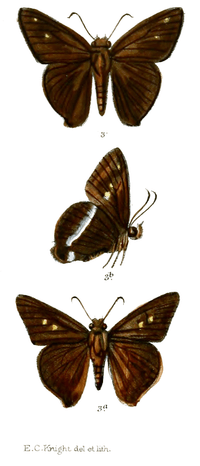Hasora vitta
Hasora vitta, the plain banded awl,[2][3][4] is a butterfly belonging to the family Hesperiidae which is found in India and parts of Southeast Asia.[5]
| Plain banded awl | |
|---|---|
.jpg) | |
| Scientific classification | |
| Kingdom: | |
| Phylum: | |
| Class: | |
| Order: | |
| Family: | |
| Genus: | |
| Species: | H. vitta |
| Binomial name | |
| Hasora vitta | |
Description

The butterfly, which has a wingspan of 45 to 55 mm, is dark brown above. It resembles the common banded awl (Hasora chromus), except in the case of having a broad white band on the under hindwing which is outwardly diffused; also, its wings are more prominently glossed.[6][7]
Other differentiating characteristics are:
Male: The upper forewing has an apical spot, sometimes with another in 3. The upper forewing has no brand.[6]
Female: The apical spot in the case of the female is larger, and there is an additional spot in 2.[6]
Taxonomy
The butterfly has two subspecies:
- Hasora vitta vitta - South Myanmar (Dawnas), Malaya peninsula, Indonesian archipelago and Philippines.[4][8]
- Hasora vitta indica - South India, Sikkim, Assam, North Myanmar, Thailand and south western China.[4][8]
Range
The plain banded awl is found in India in the south (Kanara), Sikkim, Assam[2] and eastwards to Myanmar, Thailand, western China, Malaysia, Indonesia and the Philippines.[4][8]
Host-plants
The caterpillars have been recorded on Derris spp., Pongamia spp,Millettia extensa, Endosamara racemosa, Millettia glabra and Spatholobus ferrugineus.[4][9]
Cited references
- Beccaloni, G.; Scoble, M.; Kitching, I.; Simonsen, T.; Robinson, G.; Pitkin, B.; Hine, A.; Lyal, C., eds. (2003). "Hasora vitta". The Global Lepidoptera Names Index. Natural History Museum. Retrieved April 20, 2018.
- R.K., Varshney; Smetacek, Peter (2015). A Synoptic Catalogue of the Butterflies of India. New Delhi: Butterfly Research Centre, Bhimtal & Indinov Publishing, New Delhi. p. 26. doi:10.13140/RG.2.1.3966.2164. ISBN 978-81-929826-4-9.
- TOL web page on genus Hasora
- Markku Savela's website on Lepidoptera - page on genus Hasora.
- W. H., Evans (1949). A Catalogue of the Hesperiidae from Europe, Asia, and Australia in the British Museum. London: British Museum (Natural History). Department of Entomology. p. 68.
- Wynter-Blyth, Mark Alexander (1957). Butterflies of the Indian Region. Bombay, India: Bombay Natural History Society. p. 468. ISBN 978-8170192329.
- Kunte, Krushnamegh (2000). Butterflies of Peninsular India. India, A Lifescape. Hyderabad, India: Universities Press. p. 192. ISBN 978-8173713545.
- Evans, W.H. (1932). The Identification of Indian Butterflies (2nd ed.). Mumbai, India: Bombay Natural History Society. p. 315, ser no I 1.13.
- Ravikanthachari Nitin; V.C. Balakrishnan; Paresh V. Churi; S. Kalesh; Satya Prakash; Krushnamegh Kunte (2018-04-10). "Larval host plants of the buterfies of the Western Ghats, India". Journal of Threatened Taxa. 10 (4): 11495–11550. doi:10.11609/jott.3104.10.4.11495-11550 – via JoTT.
References
- Evans, W.H. (1932). The Identification of Indian Butterflies (2nd ed.). Mumbai, India: Bombay Natural History Society.
- Kunte, Krushnamegh (2000). Butterflies of Peninsular India. India, A Lifescape. Hyderabad, India: Universities Press. ISBN 978-8173713545.
- Wynter-Blyth, Mark Alexander (1957). Butterflies of the Indian Region. Bombay, India: Bombay Natural History Society. ISBN 978-8170192329.
Online
- Beccaloni, George; Scoble, Malcolm; Kitching, Ian; Simonsen, Thomas; Robinson, Gaden; Pitkin, Brian; Hine, Adrian; Lyal, Chris. "The Global Lepidoptera Names Index (LepIndex)". Natural History Museum, London. Retrieved 2016-10-15.
- Brower, Andrew V. Z., (2007). Hasora Moore 1881. Version 21 February 2007 (under construction). Page on genus Hasora in The Tree of Life Web Project http://tolweb.org/.
- "Markku Savela's website on Lepidoptera".